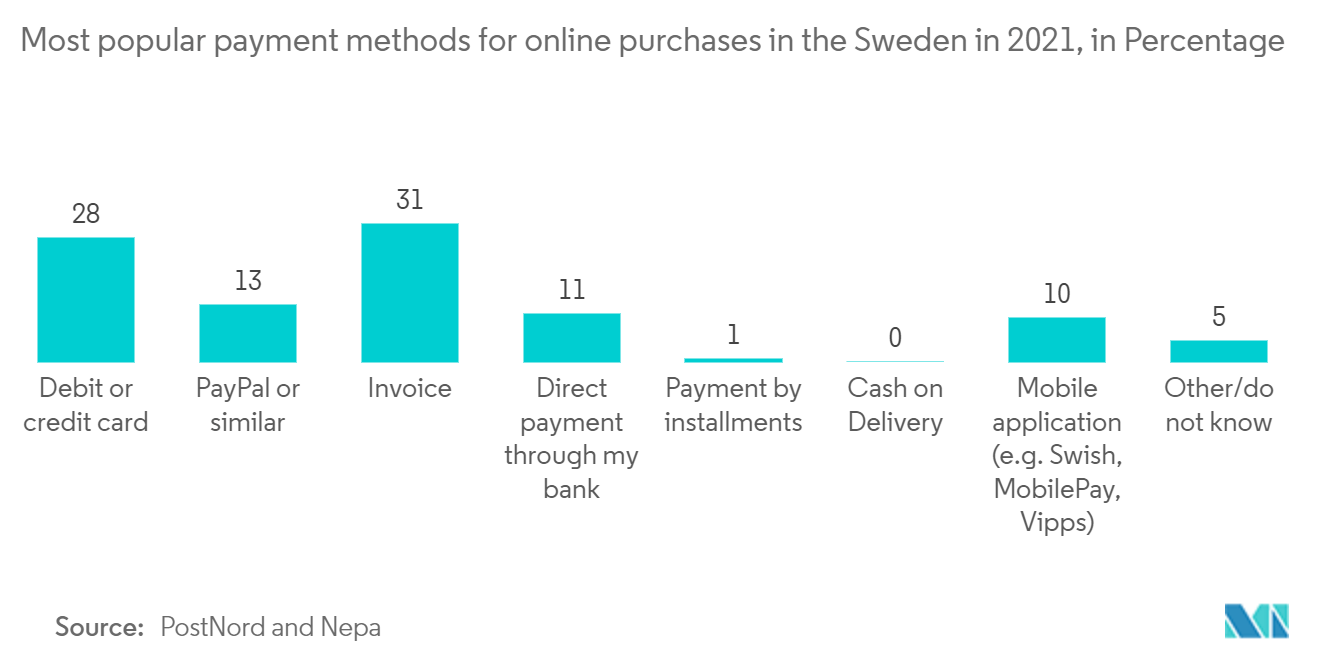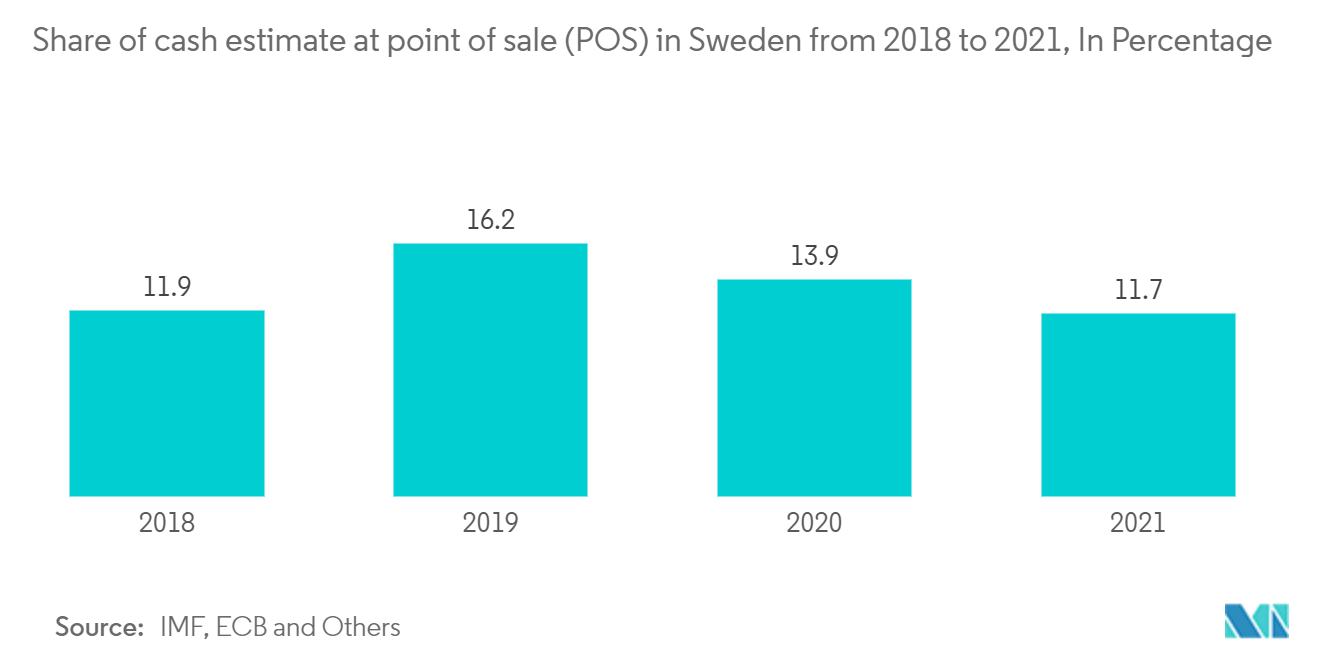Market Trends of Sweden Mobile Payments Industry
This section covers the major market trends shaping the Sweden Mobile Payments Market according to our research experts:
Proximity Segment Would Hold the Major Market Share
- For a very long time, Sweden has been at the forefront of banking innovation. Since then, payments have significantly improved and been made simpler. Sweden is currently paving the path toward a society without cash. In Sweden, the proximity payment market is anticipated to grow throughout the projected period. Following the COVID-19 outbreak, banks, fintech companies, and merchants across the country have been much more interested in proximity payments to enhance digital consumer experiences and cut costs.
- The introduction of Swish in the Swedish market made payment instant and reliable it's a service that allows users to send money from and receive money to their bank accounts via their mobile phones. To 'swish' cash to each other, the payer and the recipient need to be connected to their banks' service.
- Driving the mobile banking payment solution in May last year, Zettle rolled out its new Tap to Pay feature in Sweden, the United Kingdom, and the Netherlands enabling small businesses to accept payments directly on their Android smartphone without using a payment terminal. This solution uses NFC technology based on Proximity already available in most smartphones. It simplifies the payment process for merchants by eliminating the need to acquire a payment terminal.
- Furthermore, nowadays, almost every café, store, and supermarket in Sweden have begun to display QR codes that patrons scan code to make a mobile payment instantly. The Swish app, along with several other significant and little developments, enhances Sweden's status as a country that is becoming increasingly cashless. The QR mode of payment is widely accepted across the country because of its touchless safety, and the encryption makes the payment highly secure.
- The data from GSMA shows that there were 14.37 million cellular mobile connections in Sweden at the start of the previous year. The number of mobile connections in Sweden increased by 60 thousand (+0.4 percent) between 2021 and the last year. With an increase in smartphones, NFC technology drives cashless and contactless payments in the country. For instance, many players like apple pay and PayPal offer payment solutions using NFC technology for in-store, public transport, and bank P2P and P2B transactions using mobile apps like apple pay.
- According to PostNord and Nepa, an Invoice was the most common form of payment for online transactions in Sweden in 2021, followed by debit or credit cards.

Digitalization and Rapid Innovation Would Drive The Market
- People in Sweden are increasingly purchasing online and making digital payments. Swish is available to most people, and other mobile payment systems are also becoming more popular, particularly with younger people. Cash usage is steadily declining. The Nordic nations, particularly Norway, Sweden, and Denmark, are at the forefront of the worldwide trend toward digitizing the payments sector.
- As per the NETS payment outlook for the last year, Sweden, one of the leaders in digital banking, is predicted to be the first cashless nation by the end of this year. For many years, the national bank of Sweden, Riksbank, has been preparing the launch of a purely digital national currency, the Central Bank Digital Currency (CBDC), called e-krona. With the launch of the e- krona and the increasing number of mobile fintech solutions in the region, the prediction has become a reality.
- Sweden's payment regulatory system has a unique way of enabling its citizens to make mobile payments more secure and easy. It involves a BankID mobile app, allowing anyone with a Swedish (personal identification number) and bank account access to online banking and digital public services. The process is built around a fingerprint ID or a six-digit code on a smartphone, which has spared users from needing to remember passwords and card numbers. The central bank is also planning to expand digital currency (CBDC) in the shape of the e-krona, which has recently completed its phase 2.
- The Swedish merchants are shifting their focus to mPOS devices which help merchants turn their tablets or smartphones into a point-of-sale system anywhere with a data connection setting up a mobile payment environment with a portable EMV chip card reader and a user-friendly app. For Instance, Verifone's suite of mobile payment solutions, Zettle and Ayden, are some of the vendors providing mPOS devices in the region.
- The introduction of the P27 mode of payments in Nordic regions, enabling cross-border settlement in a real-time system through a mobile app interface, aims to establish a single pan-Nordic payment infrastructure that would facilitate an instant and seamless flow of real-time payment solutions across the region.
- Apart from Samsung Pay, Google Pay, and Apple Pay, cryptocurrencies such as Bitcoin are also getting popular as a mode of payment in the Swedish market. Bitcoin allows users to pay on a mobile device with a simple two-step scan-and-pay. By displaying the QR code in the Bitcoin wallet app, the receiver scans the sender's mobile or touches the two phones together (using NFC radio technology).
- According to IMF, ECB, and other sources, the hard cash used for all retail payments in Sweden gradually decreased in the past decade. Cash used during 2011 was approximately 21.2%, reduced to 15.7%. Notably, in the previous year, the cash used in Sweden was reduced to 11.7%. Also, it is expected that the use of hard cash in Sweden would rapidly decrease in the forecast period.


